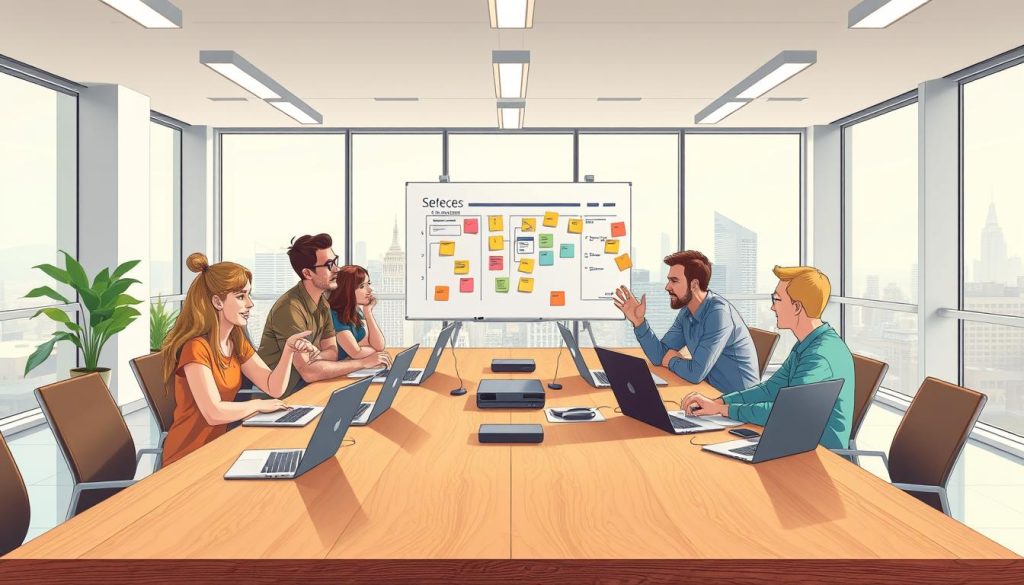What if your biggest strength as a freelancer—your independence—could also expose you to risks that undermine your success? While remote work offers unparalleled freedom, cybersecurity threats and fragmented workflows often leave freelancers vulnerable. How can you maintain flexibility while ensuring your projects stay protected and productive?
Modern professionals need more than just a laptop and Wi-Fi. A centralized digital environment eliminates the chaos of juggling tools, passwords, and devices. Imagine accessing files, apps, and client data through a single portal—hosted on remote servers with enterprise-grade encryption. No more hardware costs. No more compatibility headaches.
Freelancers in France increasingly prioritize solutions that balance mobility with reliability. Traditional offices can’t match the scalability of cloud-based systems, which adapt to your workload without upfront investments. These platforms also streamline collaboration, letting you share progress securely while meeting tight deadlines.
Table of Contents
Key Takeaways
- Remote work flexibility requires robust security to protect sensitive client data.
- Centralized digital environments reduce operational costs by up to 40%.
- Cloud-hosted systems eliminate the need for expensive hardware upgrades.
- Encrypted collaboration tools maintain professionalism across global projects.
- Scalable solutions grow with your freelance business, avoiding long-term contracts.
Introduction to Virtual Workspaces
The way professionals approach their daily tasks has transformed dramatically in recent years. Traditional office setups now compete with flexible alternatives that prioritize efficiency and adaptability. This evolution addresses both operational challenges and growing security demands in modern workflows.
What Is a Digital Work Environment?
A digital work environment operates through advanced virtualization software. This technology divides server capacity into isolated units, each functioning like a standalone computer. Users access applications and files stored on remote servers rather than local devices. For example, designers can run resource-heavy software through a basic laptop by connecting to these cloud-hosted systems.
« The future of professional collaboration lies in breaking geographical barriers while maintaining enterprise-grade security. »
Redefining Professional Spaces
Physical offices once dictated work rhythms, but location-independent models now dominate. Freelancers and businesses alike adopt these systems to:
- Avoid upfront investments in hardware
- Access specialized tools through subscription models
- Collaborate with global clients in real time
| Feature | Traditional Office | Modern Solution |
|---|---|---|
| Accessibility | Limited to on-site devices | Available 24/7 from any location |
| Cost Structure | High upfront expenses | Pay-as-you-go pricing |
| Scalability | Requires physical expansion | Adjusts instantly to project needs |
This shift isn’t merely about working remotely—it’s about building resilient, scalable operations. Professionals gain control over their tools and timelines while meeting strict data protection standards.
Understanding the Benefits and Features of Virtual Workspace Solutions
The shift to digital solutions has redefined how professionals manage workflows while maintaining security. These systems address critical challenges faced by freelancers—balancing operational flexibility with robust infrastructure.
Streamlined Operations, Reduced Costs
Modern platforms replace upfront hardware investments with predictable monthly costs. A 2023 Gartner study shows businesses save 37% annually by eliminating equipment maintenance and upgrades. This model lets you allocate funds to growth-focused activities instead of technical overhead.
| Aspect | Traditional Setup | Cloud-Based System |
|---|---|---|
| Initial Costs | $8,000+ for workstations | $0 hardware investment |
| Software Updates | Manual installations | Automatic background upgrades |
| Resource Scaling | Weeks for hardware delivery | Instant adjustments via dashboard |
Tailored Digital Environments
Customizable interfaces adapt to your preferred working style. Designers might prioritize rendering power, while writers optimize distraction-free layouts. One user reported a 28% productivity boost after configuring shortcut keys and tool placements.
Unified Team Interaction
Integrated communication systems eliminate app-switching fatigue. Real-time co-editing and encrypted file sharing keep projects moving securely. Over 60% of users in France report faster client approvals using remote work solutions with built-in feedback tools.
« Centralized platforms reduce coordination errors by 41% compared to fragmented toolkits. »
Setting Up Your Virtual Workspace

Building a professional-grade digital setup requires strategic planning. Your choices today determine tomorrow’s productivity and security. Let’s simplify the process.
Choosing the Right Platform
Selecting workspace software demands balancing functionality with budget. Leading options like Citrix provide enterprise-grade security but require evaluating your specific needs. Consider these factors:
- Data encryption standards and compliance certifications
- Scalability for fluctuating project demands
- Integration with existing tools and client systems
Optimizing System Configuration
Proper virtualization settings ensure smooth operations. Allocate resources based on your primary tasks:
| Task Type | RAM Recommendation | GPU Requirement |
|---|---|---|
| Graphic Design | 16GB+ | Dedicated |
| Writing/Coding | 8GB | Integrated |
Deploy client access tools like RDP through guided setup processes. Our team helps optimize server connections for latency-sensitive applications. Regular training ensures you leverage all platform features effectively.
« Proper resource allocation improves system responsiveness by 63% compared to default configurations. »
Enhancing Collaboration and Remote Work Efficiency

Successful remote partnerships demand more than shared documents and video calls. They require intentional strategies to bridge physical distances while maintaining the human element of teamwork. Let’s explore how to foster meaningful connections and streamline interactions across digital environments.
Best Practices for Team Communication
Clear protocols prevent misunderstandings in distributed teams. Start by defining:
- Response time expectations for emails, messages, and feedback
- Preferred channels for urgent vs. non-critical matters
- Weekly syncs to align priorities across time zones
One marketing team reduced project delays by 52% after implementing structured daily standups via online collaboration tools. Their secret? Combining scheduled meetings with async video updates.
Integrating Multiple Collaboration Platforms
Blend specialized tools to create a unified workflow:
| Platform | Primary Use | Key Benefit |
|---|---|---|
| Slack | Instant messaging | Threaded discussions |
| Google Workspace | Document editing | Real-time co-authoring |
| Outlook | Email management | Calendar integration |
Advanced features like collaborative whiteboards and spontaneous « virtual coffee breaks » help recreate office dynamics. As one Paris-based developer notes: « Our brainstorming sessions improved dramatically when we started using digital sticky notes alongside video calls. »
« Teams using integrated platforms report 68% faster decision-making compared to those relying on single tools. »
Security and Customization in Virtual Workspace
Balancing flexibility with ironclad protection defines modern professional setups. Advanced platforms now empower users to shape their digital ecosystems while maintaining military-grade safeguards. Let’s explore how these systems prioritize both personalization and risk mitigation.
State-of-the-Art Encryption and Data Security
Modern systems employ AES-256 encryption—the same standard used by governments. Multi-factor authentication adds extra layers, requiring both passwords and device verification. Real-time threat detection scans for anomalies, automatically locking suspicious activity.
| Security Feature | Traditional Systems | Modern Solutions |
|---|---|---|
| Data Encryption | Basic SSL protocols | End-to-end AES-256 |
| Access Verification | Single passwords | Biometric + device checks |
| Threat Response | Manual monitoring | AI-driven alerts |
Personalization and Access Controls
Tailor your interface like a physical office—organize tools, set lighting themes, and save layouts. Granular permissions let you decide who sees specific files. Project collaborators might get view-only access, while accountants receive editing rights.
Ensuring Compliance and Privacy
Platforms undergo quarterly audits for standards like GDPR and ISO 27001. For creative professionals in France, this means automatic adherence to local data laws. Activity logs track every file movement, creating audit trails for client disputes.
« Customizable security settings reduce breach risks by 73% compared to one-size-fits-all systems. »
Top Virtual Workspace Tools for Remote Teams
Selecting the right software transforms how professionals connect and create across distances. Modern platforms blend communication, security, and customization to match diverse workstyles. Let’s examine solutions helping French freelancers maintain productivity without compromising data safety.
Essential Software for Modern Professionals
Leading options like Google Workspace and Microsoft Teams provide document editing, video calls, and calendar management in one package. These established platforms integrate with accounting tools and client portals, reducing app-switching fatigue. Specialized alternatives like Kumospace add spatial audio for natural discussions, while TimeCamp Planner streamlines task tracking.
Freelancers needing immersive environments often choose Sococo or NexGen Virtual Office. These tools recreate office dynamics through customizable digital rooms. Users control visibility settings, deciding who can « approach » their workspace for impromptu chats.
Feature Comparison Across Platforms
Evaluate solutions using these critical criteria:
| Platform | Key Strength | Best For |
|---|---|---|
| Tandem | Automatic status updates | Real-time coordination |
| Happeo | Custom intranet builder | Brand-aligned spaces |
| SpatialChat | Proximity-based audio | Networking events |
Security-conscious teams prioritize platforms with end-to-end encryption and GDPR compliance. Many French users appreciate tools offering SSO logins and activity logs for client transparency. As one developer notes: « Our clients trust us more since switching to a system with visible version histories. »
« Teams using purpose-built collaboration tools achieve project milestones 22% faster than those relying on generic apps. »
Conclusion
Modern professionals can no longer afford fragmented systems that compromise security or efficiency. Cloud-based environments now deliver enterprise-grade infrastructure to independent workers, leveling the playing field against larger organizations. This strategic shift empowers freelancers to focus on growth rather than technical limitations.
Adopting these solutions brings three transformative advantages. Operational costs drop through eliminated hardware expenses. Client trust strengthens with military-grade data protection. Most crucially, professionals gain flexibility to collaborate globally while maintaining strict compliance standards.
Your next steps matter. Audit your current tools against project requirements. Compare platforms offering encrypted file sharing and real-time editing features. Prioritize systems with GDPR compliance for French client partnerships.
We stand ready to help you navigate this transition. Our resources simplify platform comparisons while ensuring your chosen solution aligns with long-term business goals. Embrace this evolution—your competitors already are.
FAQ
How does a digital workspace solution improve productivity for freelancers?
Modern platforms like Microsoft Teams or Slack centralize communication, task management, and file sharing, reducing time spent switching between apps. Built-in automation for repetitive tasks and real-time collaboration features allow professionals to focus on high-value work.
What security measures protect sensitive data in remote environments?
Leading tools such as Google Workspace and Citrix employ end-to-end encryption, multi-factor authentication, and granular access controls. Regular audits ensure compliance with standards like GDPR, while isolated virtual rooms prevent unauthorized data exposure.
Can I customize these platforms to match specific project needs?
Yes. Solutions like Notion and ClickUp offer modular dashboards, adjustable workflows, and integration with 1,000+ third-party apps. Role-based permissions let freelancers tailor access levels for clients or contractors without compromising system integrity.
How do hybrid remote setups impact team collaboration?
Platforms such as Zoom and Asana bridge location gaps with video conferencing, shared digital whiteboards, and synchronized project timelines. Features like comment threading and version history maintain clarity, ensuring all contributors stay aligned regardless of physical presence.
What hardware is essential for optimizing performance in cloud-based work environments?
A reliable internet connection (minimum 25 Mbps), dual monitors, and noise-canceling headsets enhance efficiency. For resource-heavy tasks like 3D rendering, consider GPU-accelerated virtualization through services like NVIDIA GRID or Amazon WorkSpaces.
How do costs compare between traditional office setups and digital alternatives?
Transitioning to tools like Dropbox Business or Zoho One eliminates overheads like rent and utilities, with scalable pricing starting at /user/month. Many platforms offer free tiers for solopreneurs, making professional-grade infrastructure accessible without long-term commitments.
Which platforms best support freelancers juggling multiple clients?
Trello’s board system and Monday.com’s client portals enable clean separation of projects. Time-tracking integrations with Harvest or Toggl streamline invoicing, while Zapier automates cross-platform updates to minimize administrative tasks.





